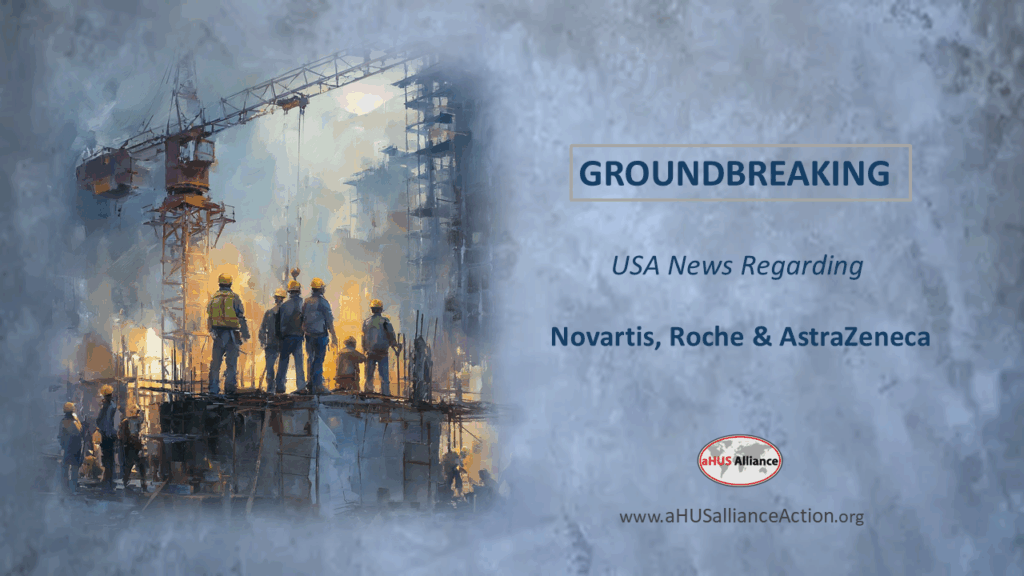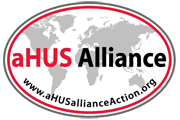
Some in the USA rare disease community were wondering how this scenario would unfold – now we know. Well, at least in part.
Here’s a bit of ‘horizon scanning’ for people whose treatment regime and disease management plans include complement inhibitors eculizumab and ravulizumab (products Soliris® & Ultomiris® , manufacturer Alexion, AstraZeneca Rare Disease).
Those with the rare disease atypical hemolytic uremic syndrome (atypical HUS or aHUS) aren’t the only ones watching for news related to complement-mediated or TMA treatments and clinical trial updates. The U.S. Food and Drug Administration (US FDA) additionally has approved eculizumab for the following conditions as well: PNH, gMG, and NMOSD.
There’s been movement in biosimilars to eculizumab coming to market as well, with examples like the FDA approval for ‘act alike’ biosimilar drugs to treat aHUS and PNH which reference eculizumab: Bkemv® (eculizumab-aeeb, manufacturer Amgen) and Epysqli® (eculizumab-aagh, manufacturer Samsung Bioepis)
A stark reality for patients is that many nations have restricted access to expensive biopharmaceutical drugs due to small rare disease populations, in favor of healthcare dollars allocated to medical conditions which affect greater numbers of people in their nation. Simply put, as an economic reality: drug cost drives drug access. (Background Basics: see our original articles on biosimilars and small molecule drugs v. biologics)
The atypical HUS community is fortunate, as aHUS is among the 5% of the approximately 7,000 to 10,000 known rare diseases have an FDA-approved treatment (NORD). However the majority of nations do not have national rare disease policies and/or healthcare/reimbursement plans which support ‘best practice’ drugs and disease management to treat aHUS patients. The aHUS Aliance Global Action team has written extensively both patient treatment options and preferences, as well as drug access and treatment duration issues.
What people in the USA are looking at now is the intersection of drug cost with changes in national policies. Politics aside, what’s basically on the horizon is the United State’s current efforts to bring drug manufacturing back to US soil. Here are some of the points to ponder:
*It seems that bringing drug manufacture to America will ensure drug an uninterruped drug supply, and likely no effect on cost as tariffs will be avoided. How do the economics and drug supply shake out or trickle down for those patients in other nations than America?
*Drug R & D: What effect will this have on drug research and development? Will clinical trials and their progress to date be hindered, accelerated, or not be impacted by this?
*Biosimilars: How does this affect plans for USDFA approved biosimilars to ravulizumab, and for future reference drugs? Will there be more pharma expanding ttheir pipelines, with broader access and lower costs, or will the reverse occur?
*What may be projected for potential impacts affecting other nations, regarding pharmaceutical companies’ commitment to American facilities and programs? For drug access and costs? Regarding socioeconomic aspects? For facets tangential to research and to pipeline development?
*Will there be a shift to greater exploration and development of drug candidates with different profiles, to include small molecule drugs which are easier/less costly to manufacture? What about aHUS drugs with oral or subcutaneous delivery, will more USA-based facilities yield a boom in drug research and development?
(Note: Novartis, Roche, and Alexion AstraZeneca Rare Disease all have either approved drugs or drugs currently in clinical trials for atypical HUS. Our aHUS Alliance Global Action team provides an authentic voice for the international atypical HUS community, presenting insights and content for informational purposes only, and which are not intended as an endorsement or recommendation.)
Via Press Releases & Fierce Pharma (Reverse Date Order)
Novartis plans to expand its US-based manufacturing and R&D footprint with a total investment of $23B over the next 5 years (Apr 10, 2025: Novartis, PRNewswire)
“Today, Novartis, a leading global innovative medicines company, announced a planned $23 billion investment over 5 years in US-based infrastructure, ensuring all key Novartis medicines for US patients will be made in the United States. This commitment enables Novartis to expand on its current manufacturing, research and technology presence across the country with 10 facilities, including 7 brand new facilities, creating nearly 1,000 new jobs at Novartis and approximately 4,000 additional US jobs.”
Roche to swell US footprint with sweeping $50B investment, furthering pharma’s onshoring push (By Zoey Becker Apr 22, 2025)
“With the threat of pharmaceutical tariffs hanging over the biopharmaceutical industry, Roche is the latest addition to a growing list of major drugmakers that are bolstering their manufacturing footprints in the U.S.”
AstraZeneca plans $50B investment in US, including massive plant in Virginia (By Kevin Dunleavy Jul 22, 2025)
“With the threat of tariffs looming for medicines imported to the United States, AstraZeneca has unveiled a plan to invest $50 billion in the country by 2030.” and
“The massive commitment comes on top of several other companies revealing similar initiatives in the U.S.”
AstraZeneca kicks off construction of $4.5B API plant in Virginia (By Kevin Dunleavy Oct 9, 2025)

